2 X MARBEL ANGELFISH MIX MALE AND FEMALE ANGEL SIZE 2-4 CM, Stunning Colorful Angelfish, Ideal Friends for Neon Tetras and Corydoras Catfish in a Peaceful Aquarium Setting, Perfect for Community Tanks
£25.99 Original price was: £25.99.£22.00Current price is: £22.00.
Discover the joy of keeping Marble Angelfish! This listing includes 2 individual fish, one male and one female. Ideal for aquarists asking ‘what fish are easy to care for?’, these beautiful creatures flourish in a community tank with neon tetras and corydoras catfish.
Species Introduction
The Marble Angelfish, scientifically known as Pterophyllum scalare, belongs to the family Cichlidae and is a stunning addition to any freshwater aquarium. Originating from the Amazon Basin in South America, these beautiful fish are known for their vibrant colors and graceful swimming patterns. In their natural habitat, they thrive in slow-moving waters, often found in rivers and streams surrounded by lush vegetation. The Marble Angelfish is particularly admired for its unique marble-like patterns, which can vary widely among individuals, making each fish a unique work of art. With a maximum length of approximately 15 cm, these fish are not only visually appealing but also relatively easy to care for, making them a popular choice for both novice and experienced aquarists.
Care Requirements Dashboard
Essential Care Guide for Marble Angelfish
| Optimal Living Conditions | |
|---|---|
| Water Temperature | 22-28°C (72-82°F) |
| pH Level | 6.0-7.5 |
| Water Hardness | 2-15 dKH |
| Minimum Tank Size | 120L (30 gal) |
| Salinity | Freshwater |
| Care Level | Beginner to Intermediate |
Natural Behavior & Temperament
Marble Angelfish are known for their peaceful and social nature, making them ideal companions in a community aquarium setting. They exhibit graceful swimming patterns and often prefer to occupy the mid to upper levels of the tank. In a peaceful aquarium environment, these fish can exhibit fascinating behaviors, such as pairing up and displaying courtship rituals. They are generally non-aggressive but may become territorial, especially during breeding. It is essential to provide ample hiding spots and swimming space to accommodate their natural behaviors. When kept with compatible tank mates like Neon Tetras and Corydoras Catfish, Marble Angelfish can thrive, creating a harmonious aquatic community.
Tank Setup Guide
Setting up a tank for Marble Angelfish requires careful consideration of their natural habitat. A minimum tank size of 75 liters is recommended to provide ample swimming space and to accommodate their social nature. The substrate should be soft and sandy, allowing for easy digging and foraging. Incorporating live plants not only enhances the visual appeal but also provides hiding spots and contributes to water quality. Floating plants can help diffuse light and create a more natural environment. Additionally, rocks and driftwood can be arranged to create territories and caves, which can help reduce stress and aggression among tank mates. Ensure that the tank is well-cycled before introducing these beautiful fish, as stable water conditions are crucial for their health.
Water Quality Management
Maintaining optimal water quality is essential for the health and well-being of Marble Angelfish. The ideal water temperature should range between 24 to 28 degrees Celsius, with a pH level of 6.5 to 7.5. Regular water changes of 20-30% weekly are recommended to keep nitrate levels low and to ensure a clean environment. It is crucial to monitor water hardness, which should be maintained between 5 to 15 dGH. Using a high-quality aquarium filter will help maintain water clarity and quality. Additionally, testing kits for pH, ammonia, nitrite, and nitrate levels should be utilized regularly to ensure that the water parameters remain stable. Healthy water conditions are vital for preventing diseases and promoting the overall vitality of your Marble Angelfish.
Feeding & Nutrition
Marble Angelfish are omnivorous and thrive on a varied diet. A balanced feeding regimen should include high-quality flake food, pellets, and occasional treats such as frozen or live foods like brine shrimp, bloodworms, and daphnia. It is essential to feed them small amounts 2-3 times a day, ensuring that all food is consumed within a few minutes to prevent water contamination. Overfeeding can lead to health issues, so monitoring their intake is crucial. Additionally, incorporating vegetable matter, such as spirulina or blanched peas, can enhance their diet and promote healthy digestion. A well-rounded diet not only supports their growth and vitality but also enhances their vibrant colors, making them even more stunning in your aquarium.
Compatibility Guide
When considering tank mates for Marble Angelfish, it is essential to select peaceful species that can coexist harmoniously. Ideal companions include Neon Tetras, Corydoras Catfish, and other small to medium-sized community fish. Avoid aggressive species or those that may nip at their fins, as this can lead to stress and health issues. It is advisable to keep them in groups of at least four to reduce stress and promote natural behaviors. Properly researching and understanding the compatibility of each species is vital for creating a thriving community aquarium.
Tank Mate Compatibility Guide
Great Tank Mates
- Other peaceful community fish
- Corydoras catfish
- Small tetras
- Peaceful dwarf shrimp
Avoid These Tank Mates
- Aggressive cichlids
- Large predatory fish
- Fin nippers
Compatibility Note: Always research specific species requirements and observe fish behavior when introducing new tank mates. Individual fish personalities can vary!
Health & Wellness
Maintaining the health and wellness of Marble Angelfish involves regular monitoring and preventive care. Common issues include ich, fin rot, and swim bladder disease. Signs of illness may include lethargy, loss of appetite, or abnormal swimming behavior. It is crucial to act quickly if any signs of distress are observed. Regular water testing and maintenance can prevent many health issues. Additionally, providing a varied diet and ensuring proper tank conditions contribute significantly to their overall health. In case of illness, quarantining affected fish and treating them in a separate tank can help prevent the spread of disease to other aquatic companions.
Breeding Information
Breeding Marble Angelfish can be a rewarding experience for aquarists. These fish are egg layers and typically prefer to spawn on flat surfaces, including leaves, rocks, or breeding cones. To encourage breeding, it is essential to provide a separate breeding tank with optimal conditions, including slightly warmer water temperatures and clean, well-oxygenated water. Once the female lays eggs, both parents will often guard and care for the eggs until they hatch, which usually takes about 48 hours. After hatching, the fry can be fed infusoria or finely crushed flakes until they are large enough to consume larger foods. Proper care of the fry is crucial to ensure their survival and growth.
Acclimation Process
Introducing Marble Angelfish to a new tank requires a careful acclimation process to minimize stress and ensure a smooth transition. Begin by floating the sealed bag containing the fish in the aquarium for about 15-20 minutes to equalize the temperature. After this, gradually introduce small amounts of tank water into the bag over the course of an hour. This process helps the fish adjust to the new water parameters. Finally, gently transfer the fish into the tank using a net, avoiding adding the bag water to the aquarium. This method reduces the risk of introducing any contaminants from the bag into the tank.
Long-term Care
Marble Angelfish can live for several years with proper care, often reaching ages of 10 years or more in a well-maintained aquarium. As they grow, it’s essential to monitor their size and adjust tank conditions accordingly. Regular water changes, consistent feeding schedules, and vigilant monitoring of their health will contribute to their longevity. Additionally, maintaining a stable environment with minimal stressors will help ensure their well-being. Providing a balanced diet and ensuring compatibility with tank mates will also enhance their quality of life.
Natural Habitat Recreation
Recreating the natural habitat of Marble Angelfish in your aquarium can enhance their overall well-being. Consider using a substrate that mimics the sandy bottoms of their native rivers, and incorporate a variety of plants to simulate the lush vegetation they thrive in. Floating plants can provide shade and help diffuse lighting, creating a comfortable environment. Additionally, using driftwood and rocks can create hiding spots and territories, which are essential for their natural behaviors. By replicating their natural habitat, you can create a thriving ecosystem that benefits both the fish and the overall aesthetic of your aquarium.
Seasonal Care Adjustments
Seasonal changes can impact the care requirements of Marble Angelfish. During warmer months, it may be necessary to monitor water temperatures closely to prevent overheating. Using fans or chillers can help maintain optimal conditions. In contrast, during colder months, ensuring that the aquarium heater is functioning correctly is crucial to maintain stable temperatures. Additionally, adjusting lighting schedules to mimic natural daylight cycles can help regulate their behavior and promote healthy growth. Being aware of these seasonal changes and making necessary adjustments will contribute to the overall health and happiness of your Marble Angelfish.
Expert Tips
For those looking to provide the best care for their Marble Angelfish, consider the following expert tips: Regularly test water parameters to ensure they remain within the ideal ranges, as fluctuations can lead to stress and health issues. Incorporate a variety of foods to promote vibrant colors and overall health. It is also beneficial to observe their behavior closely; any changes may indicate health concerns. Lastly, establishing a routine for tank maintenance, including cleaning and water changes, will help create a stable environment conducive to their well-being. By following these tips, you can ensure a thriving aquarium filled with these beautiful aquatic companions.
Troubleshooting
Even with the best care, issues can arise with Marble Angelfish. Common problems include stress from aggressive tank mates, poor water quality, and dietary deficiencies. If your fish are exhibiting signs of stress, such as hiding or erratic swimming, it may be necessary to reassess tank conditions and compatibility. Regular water testing can help identify issues before they escalate. If signs of illness appear, such as white spots or fin damage, consider isolating the affected fish and consulting with a veterinarian or aquatic specialist for appropriate treatment options. Proactive management and observation are key to maintaining a healthy aquarium.
Scientific Background
The Marble Angelfish, Pterophyllum scalare, is part of the Cichlidae family, which encompasses a diverse range of freshwater fish. This species is particularly notable for its unique body shape and striking coloration, which has made it a favorite among aquarists. Research into their behavior and ecology has provided valuable insights into their care and breeding habits. Conservation efforts are also essential to protect their natural habitats from environmental threats, ensuring that future generations can enjoy these beautiful fish. Understanding their scientific background can enhance the appreciation and care for Marble Angelfish in home aquariums.
Advanced Care Techniques
For experienced aquarists looking to elevate their care for Marble Angelfish, consider implementing advanced techniques such as breeding pair selection and conditioning. Creating a breeding environment with optimal water conditions and providing high-quality foods can enhance spawning success. Additionally, utilizing a separate breeding tank can help manage fry care more effectively. Regularly rotating tank decorations and plants can also stimulate natural behaviors and reduce stress. Engaging in ongoing education about aquatic husbandry will further enhance your ability to provide a thriving environment for these exquisite fish.
Water Quality Parameters
Optimal Range
Caution Zone
Danger Zone
Monitoring Tip: Test water parameters weekly and perform regular water changes to maintain optimal conditions for your aquatic friends!
Frequently Asked Questions
Q: What tank size is required for Marble Angelfish?
Marble Angelfish thrive in a minimum tank size of 100 litres. This allows ample space for swimming and establishing territories. A larger tank is advisable if you plan to keep multiple angelfish, as they can be territorial, especially during breeding. Ensure the tank is well-filtered and has a secure lid, as angelfish are known to jump. Providing a spacious environment not only promotes the health of your fish but also helps maintain stable water parameters, which are crucial for their well-being.
✓ Expert Tip
Consider incorporating vertical space with tall plants or decorations, as angelfish enjoy exploring different levels of the aquarium.
Q: What water parameters do Marble Angelfish require?
Marble Angelfish prefer slightly acidic to neutral water, ideally between pH 6.5 and 7.5. The temperature should be maintained between 24°C and 28°C. Regular water changes of 10-15% weekly are essential to keep the water quality high, as angelfish are sensitive to poor conditions. Ammonia and nitrite levels should remain at 0, while nitrates should be kept below 20 mg/L for optimal health. Installing a reliable filtration system and using a water conditioner can help maintain these parameters.
✓ Expert Tip
Invest in a good quality test kit to monitor your water parameters regularly, ensuring a healthy environment for your angelfish.
Q: How often should I feed Marble Angelfish?
Marble Angelfish should be fed two to three small meals daily. A varied diet is crucial for their health, including high-quality flakes, pellets, and occasional live or frozen foods such as brine shrimp or bloodworms. Overfeeding can lead to health issues, so ensure each feeding lasts only a few minutes, allowing them to consume everything without leftovers. Monitor their body condition to adjust feeding amounts as necessary.
✓ Expert Tip
Consider using a feeding ring to prevent food from floating away, ensuring your fish can access their meals easily.
Q: What are the best tank mates for Marble Angelfish?
Marble Angelfish are generally peaceful but can exhibit territorial behaviour, especially during breeding. Ideal tank mates include small, non-aggressive species such as Neon Tetras and Corydoras Catfish. Avoid keeping them with fin-nippers or overly aggressive fish, as this can lead to stress or injury. When introducing new tank mates, ensure there is plenty of space and hiding spots to reduce aggression and allow all fish to establish their territories comfortably.
✓ Expert Tip
Introduce new fish slowly and monitor their interactions to ensure harmony within your aquarium community.
Q: How do I properly acclimatise Marble Angelfish to my aquarium?
Acclimatising your Marble Angelfish is crucial to minimise stress. Start by floating the sealed bag in your aquarium for about 15 minutes to equalise the temperature. Then, gradually add small amounts of aquarium water into the bag every 5-10 minutes for about an hour. This process helps them adjust to the water parameters in your tank. After this period, gently release the fish into the aquarium using a net to avoid adding bag water, which may contain unwanted substances.
✓ Expert Tip
Avoid putting the fish directly into the tank from the bag, as this can shock them and lead to health issues.
Q: What are the signs of healthy Marble Angelfish?
Healthy Marble Angelfish exhibit vibrant colours and clear, unclouded eyes. Their fins should be extended, not clamped, and they should swim actively without signs of distress. Look for signs of good appetite and normal behaviour patterns, such as exploring their environment. Any sudden changes in behaviour, such as lethargy or hiding, can indicate stress or illness. Regular monitoring of these signs can help you catch potential health issues early.
✓ Expert Tip
Keep a close eye on your fish during the first few weeks after introducing them to identify any health concerns early.
Q: How do I successfully breed Marble Angelfish?
Breeding Marble Angelfish requires specific conditions. They prefer a breeding pair, which can be identified by their behaviour and size differences. Provide a breeding tank with flat surfaces for laying eggs, such as slate or broad-leaved plants. Maintain a temperature of around 26°C and ensure excellent water quality. After spawning, the parents will guard the eggs, which hatch in about 48 hours. Remove any uneaten eggs to prevent fungal infections, and provide suitable food for the fry once they are free-swimming.
✓ Expert Tip
Consider using a separate breeding tank to avoid stress to the parents and protect the fry from other tank mates.
Q: What temperature should I maintain for Marble Angelfish?
Marble Angelfish thrive in water temperatures ranging from 24°C to 28°C. Maintaining a consistent temperature within this range is crucial for their health and activity levels. Sudden fluctuations can lead to stress and may compromise their immune systems, making them susceptible to diseases. Using a reliable aquarium heater with a thermometer will help you monitor and maintain the temperature effectively.
✓ Expert Tip
Place the heater near the filter outlet to ensure even distribution of warmth throughout the tank.
Q: How long do Marble Angelfish typically live in captivity?
With proper care, Marble Angelfish can live for 10 to 15 years in captivity. Factors influencing their lifespan include water quality, diet, and tank conditions. Regular maintenance, including water changes and monitoring for diseases, is essential to prolong their life. Providing a stress-free environment with compatible tank mates also contributes to their overall well-being and longevity.
✓ Expert Tip
Aim to replicate their natural habitat as closely as possible to enhance their quality of life and lifespan.
Q: What type of substrate is most suitable for Marble Angelfish?
Marble Angelfish do well with a substrate that mimics their natural habitat. Fine gravel or sand substrates are ideal, as they allow for easy movement and foraging. Avoid sharp-edged substrates, as they can injure the fish. Additionally, incorporating live plants and decorations can create a more enriching environment, providing hiding spots and reducing stress levels.
✓ Expert Tip
Layering your substrate with nutrient-rich soil underneath can promote healthy plant growth, enhancing the overall aesthetics of your aquarium.
Q: What behavioural patterns should I expect from Marble Angelfish?
Marble Angelfish are known for their serene yet curious behaviour. They enjoy exploring their environment and often display social interactions, especially when kept in pairs. During breeding, they may become more territorial, asserting dominance over their space. Typically, they will swim gracefully throughout the tank, often hovering near plants or decorations. Observing their behaviour can provide insights into their health and well-being.
✓ Expert Tip
Create a varied environment with plants and hiding spots to encourage natural behaviours and reduce stress.
Q: How can I prevent common diseases in Marble Angelfish?
Preventing diseases in Marble Angelfish involves maintaining high water quality and a stable environment. Regular water changes and monitoring parameters are essential. Quarantine new fish before introducing them to your aquarium to prevent introducing pathogens. A varied diet rich in nutrients can strengthen their immune systems. Additionally, keeping the tank clean and free from waste will help prevent issues such as ich or fin rot.
✓ Expert Tip
Consider adding aquarium salt in moderation to help prevent certain diseases and promote gill function.
Q: What lighting conditions do Marble Angelfish prefer?
Marble Angelfish thrive under moderate lighting conditions. Bright light can cause stress, so providing shaded areas with plants or decorations is beneficial. A light cycle of about 10-12 hours per day is ideal to simulate natural conditions. Use LED lights or fluorescent tubes that enhance the colours of the fish while ensuring the tank environment remains comfortable. Adjust lighting based on the presence of live plants, which may require more light.
✓ Expert Tip
Consider using a timer to maintain consistent lighting, which promotes a natural day-night cycle.
Q: How do I recognise stress in Marble Angelfish?
Signs of stress in Marble Angelfish include changes in behaviour, such as hiding, reduced activity, or erratic swimming. Their fins may be clamped against their bodies, and they may exhibit a loss of appetite. Additionally, look for colour fading or unusual markings. Environmental factors such as poor water quality, overcrowding, or aggressive tank mates can contribute to stress. Addressing these issues promptly can help restore their health and behaviour.
✓ Expert Tip
Regularly observe your fish and their environment to catch signs of stress early, allowing you to take corrective action.
Q: What natural habitat conditions should I replicate for Marble Angelfish?
In their natural habitat, Marble Angelfish are found in warm, slow-moving waters with plenty of vegetation. To replicate these conditions, provide a well-planted aquarium with hiding spots and open swimming areas. Using dark substrate can mimic the riverbeds they inhabit. Maintain stable water parameters, including temperature and pH, to create a comfortable environment. Regularly adding leaf litter can also help replicate their natural surroundings and provide additional benefits.
✓ Expert Tip
Consider using botanicals to help create a natural bioactive environment that benefits your fish.

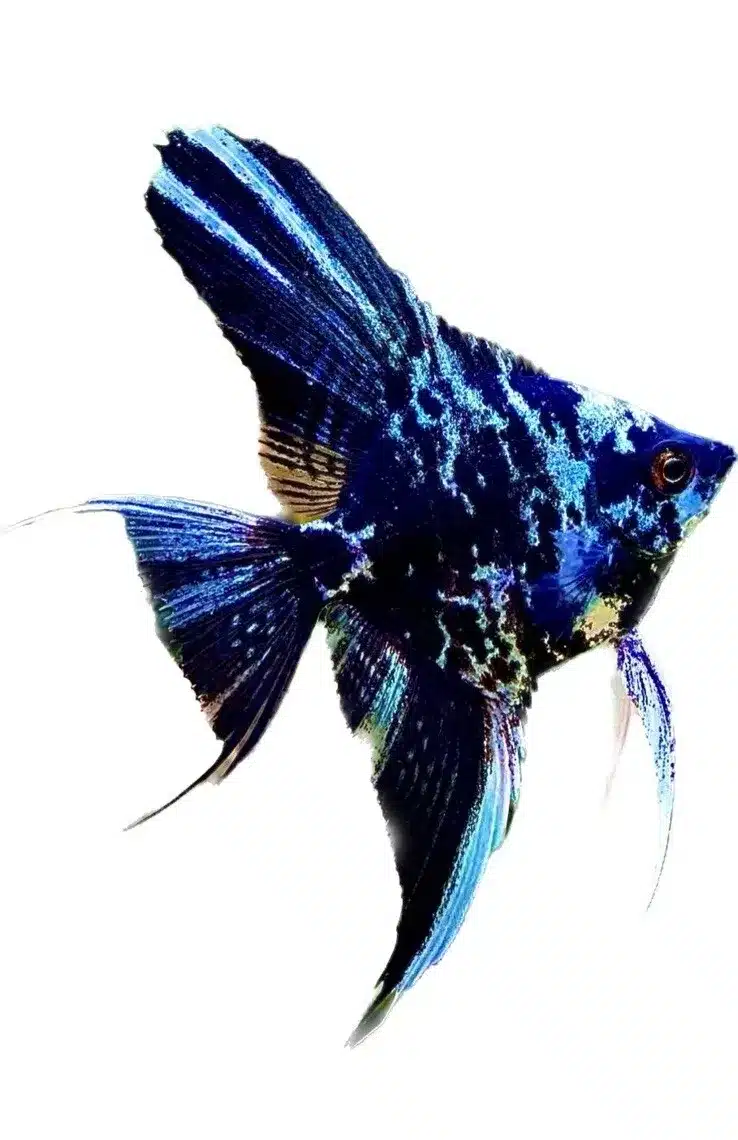


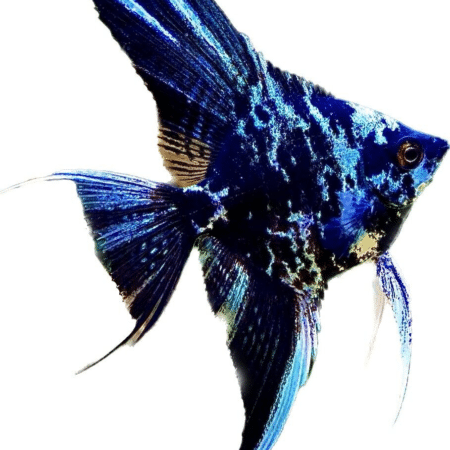
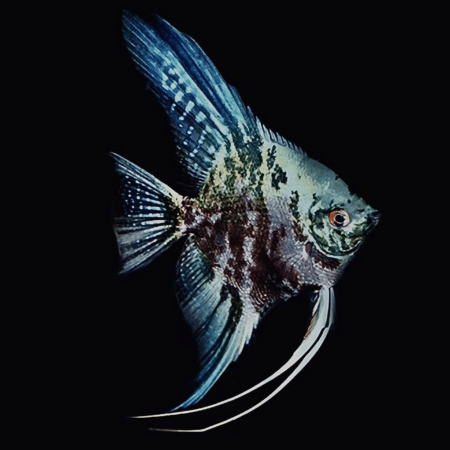
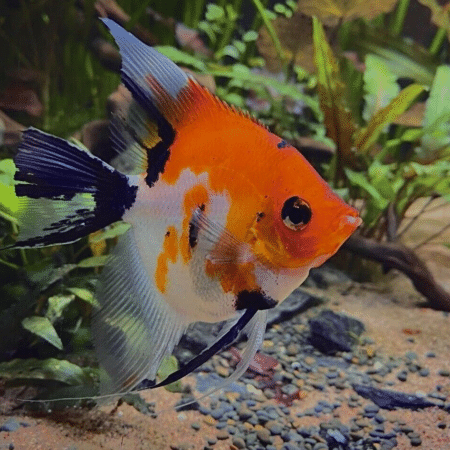

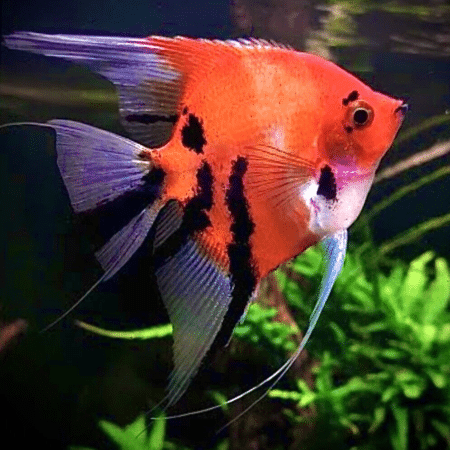
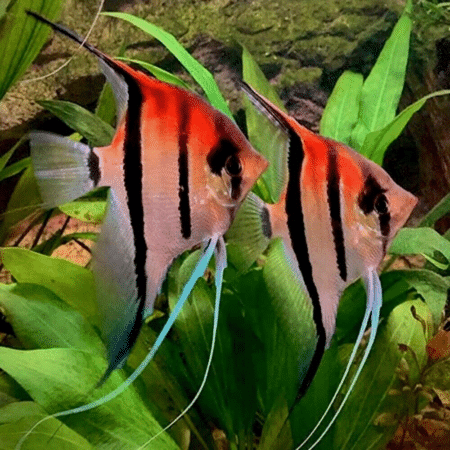
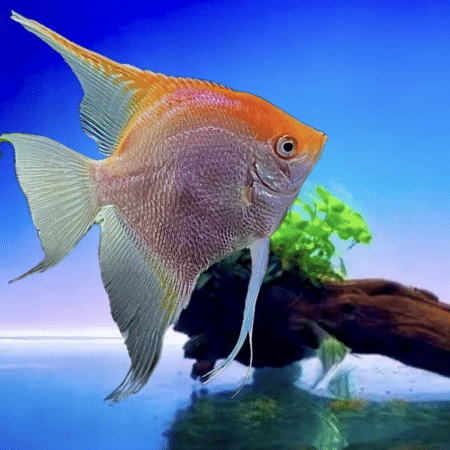

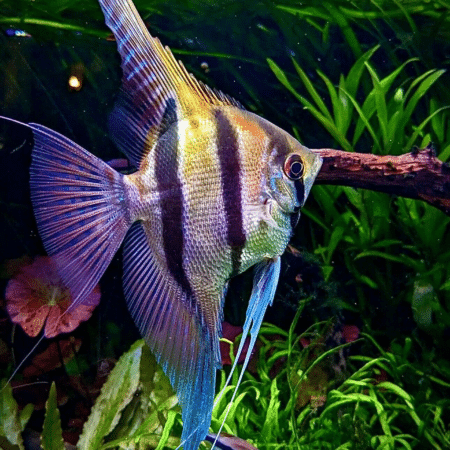
Emily Carter (verified owner) –
I recently purchased the 2 X Marble Angelfish mix and I couldn’t be more thrilled! As a passionate aquarium hobbyist, I have kept various freshwater fish, but these little beauties are something special. After just a week in my 55-gallon tank, they have settled in wonderfully and have become the stars of the show. Their captivating patterns and graceful movements add so much life to my aquarium. I’ve housed them with my neon tetras, and they coexist beautifully.
One of my favorite observations is how they interact with each other; they are definitely a dynamic pair! The size of 2-4 cm is perfect for my tank, and I’ve noticed the male displaying vibrant colors as he establishes his territory. I did have a minor concern about their initial shyness, but that quickly faded once they got used to their new home.
For anyone considering adding angelfish to their collection, I wholeheartedly recommend these marble angelfish. They’re perfect for both beginners and experienced enthusiasts alike. Just be sure to monitor water parameters to keep them happy and thriving. Shipping was prompt, and they arrived healthy and vibrant. I would definitely buy again!
Emily Richards (verified owner) –
I recently purchased the 2 X Marbel Angelfish Mix (male and female) for my 50-gallon community tank, and I couldn’t be happier! After about two weeks, they have settled in beautifully and added such vibrant colors to my aquarium. The angelfish, ranging from 2-4 cm, are a stunning sight, swimming gracefully among my neon tetras and Corydoras catfish. I was worried about compatibility, but these angelfish are gentle and fit perfectly into my peaceful aquarium setting.
What I appreciate most is their active nature without being aggressive. It’s fascinating to watch them interact with the other fish. They really bring a lively dynamic to the tank without disturbing the tranquility. My only minor concern is that they do enjoy some vertical space, so I’ve added a few tall plants for them to explore, which they seem to love!
I highly recommend these angelfish for anyone looking to enhance their community tank. They are perfect for beginner to intermediate hobbyists who want colorful, engaging fish that coexist well with other species. Shipping was also quick, and they arrived healthy and vibrant. I would definitely buy again!